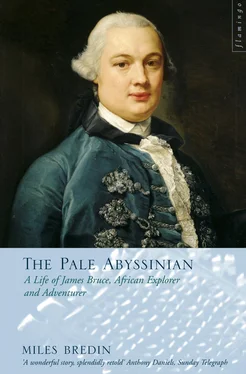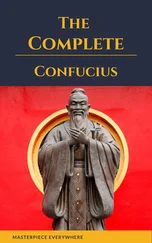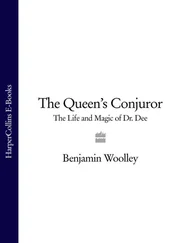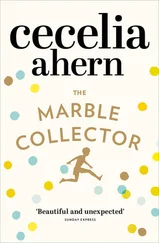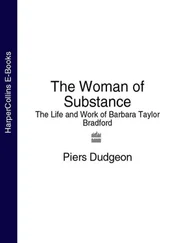The voyage up the Nile was by necessity a leisurely one. Abou Cuffi, though skilled, was often drunk and the wind was, at that season, ill-suited to their journey. Many mornings they had to employ people to tow them against the current. Bruce was enjoying himself, however. He made friends with the Sheikh of the Howadat, a local tribe, and on the first two days went off on archaeological excursions, returning to the boat at night. This qualified him to do something he loved – argue about the findings of his predecessors: ‘Mr Niebuhr, the Danish traveller, agrees with Dr Pococke [about the location of Memphis]. I believe neither Shaw nor Niebuhr were ever at Metrahenny’.
Bruce was not a man to worry about libel or speaking ill of the dead so he carried on for another twenty pages. It is the one point in the Travels when he realizes he might be over egging the pudding: ‘Our wind was fair and fresh, rather a little on our beam; when, in great spirits, we hoisted our main and fore-sails, leaving the point of Metrahenny, where our reader may think we have too long detained him’.
The journey had started in earnest. From Cairo onwards, every night Balugani would calculate the temperature and Bruce would take the longitude and latitude. They would record detailed notes of everything they did, things they saw and customs they observed. Until now they had been on an extremely well-organized painting tour but from the moment they left Cairo they were on a scientific expedition, measuring, weighing and recording everything they came across. The tables on which they measured the weather and distances they travelled are amazing documents in themselves, not merely for the information they contain. Even when they were sick from tiredness or seriously ill, Bruce would take the readings and Balugani would enter them. Bruce even charted every twist and turn of the Nile, inserting the names of the villages along the way, marking accurate longitude and latitude measurements that had never before been available. He was determined that his journey should not merely be a jaunt. This was not a sponsored expedition, but neither was it that of a rich young man going off to find himself: Bruce wanted it to be useful. It was to be a well-documented voyage of discovery, of value to people who followed in his footsteps. For he was quite sure of one thing: follow they would.
Every night they had to post guards, for the villages they passed through were teeming with robbers, notorious for swimming out to anchored boats and stealing anything they could lay their hands on. They encountered trouble only when Bruce broke his own rules and tried to visit some ruins in a place where he had no introduction to the locals.
Abou Cuffi’s son Mahomet went on shore, under pretence of buying some provision, and to see how the land lay, but after the character we had of the inhabitants, all our fire-arms were brought to the door of the cabin. In the meantime, partly with my naked eye and partly with my glass, I observed the ruins so attentively as to be perfectly in love with them.
Bruce was destined to venture no closer. Mahomet came racing back to the boat – his turban stolen – with the entire village chasing after him. A few shots were fired at the boat and they cast off hurriedly whilst Bruce ranted at the villagers.
I cried out in Arabic, ‘Infidels, thieves, and robbers! come on, or we shall presently attack you:’ upon which I immediately fired a ship blunderbuss with pistol small bullets, but with little elevation, among the bushes, so as not to touch them. The three or four men that were nearest fell flat upon their faces, and slid away among the bushes on their bellies, like eels, and we saw no more of them.
Their progress was unhurried but they were covering a lot of ground and learning a great deal: ‘I was then beginning my apprenticeship, which I fully completed,’ remarked the explorer. One minute he would be drawing pictures of irrigation methods in his commonplace book and measuring the height of the wheat growing in the thin strip of land between the mountains that run parallel with the Nile, the next he would be exposing myths for future publication: ‘I was very pleased to see here, for the first time, two shepherd dogs lapping up the water from the stream, then lying down in it with great seeming leisure and satisfaction. It refuted the old fable, that the dogs living on the banks of the Nile run as they drink, for fear of the crocodile’. He never entirely cured himself of these bizarre asides which, though irksome to the scholar, are a delight to the general reader (for whom, in the end, he wrote). The running dogs of the Nile, now unheard of, were evidently well-known to eighteenth-century audiences.
Each day they would stop at whichever ruin happened to be next and from studying them Bruce came to many conclusions, some of which were correct, others less so. He guessed the location of Memphis correctly, but when he visited Cleopatra’s and Caesarian’s temple at Dendera, he decided that the ancient Egyptians must all have lived in caves because he could only find the remains of temples and graves. He also came to some rather startling conclusions about the Egyptian language which he drew from his study of the hieroglyphics: that it grew out of Ethiopic. All these, though, must be taken in context for his was a rapid progress of the Nile and he had no time to do any detailed research. He does not claim to be an oracle on these points.
At Thebes, however, Bruce made an important discovery; important not only because he was the first person to describe an intriguing facet of Egyptian life, but also because it led to his being disbelieved when he returned to London. In the tomb of Rameses III he discovered a painting of a ‘man playing upon a harp’ thus dating anew the origins of music. The occupant of the tomb was not known at the time. Until this was verified, it became known, after his death – through the respectable medium of Murray’s guide book of Egypt – as Bruce’s Tomb.
The whole principles on which this harp is constructed, are rational and ingenious, and the ornamented parts are executed in the very best manner.
The bottom and sides of the frame seem to be fineered, and inlaid, probably with ivory, tortoise-shell, and mother of pearl, the ordinary produce of the neighbouring seas and deserts. It would be even now impossible, either to construct or to finish a harp with more taste or elegance.
Everything which Bruce wrote and said about this harp and its player is true. The fresco is still there, complete with Bruce’s graffito upon it. It was, however, greeted with incredulity by many of his compatriots on his return to London. He described the harp to Doctor Burney, the musicologist, who then asked Bruce to write an article about it for his forthcoming History of Music. It was Bruce’s first published writing and the reaction to it gave Bruce a chastening introduction to public criticism. Fanny Burney, Dr Burney’s daughter, was quite wrong in her expectation of how Bruce’s letter and paintings would be received when published. She wrote in her diary:
Mr Bruce, that Great Lyon, has lately become very intimate with my father, and has favoured him with two delightful original drawings, done by himself, of instruments which he found at the Egyptian Thebes, in his long and difficult and enterprising travels, and also with a long letter concerning them, which is to be printed in the History. These will be great ornaments to the book; and I am happy to think that Mr Bruce, in having so highly obliged my father, will find by the estimation he is in as a writer, that his own name and assistance will not be disgraced, though it is the first time he has signed it for any publication, with which he has hitherto favoured the world.
Читать дальше
